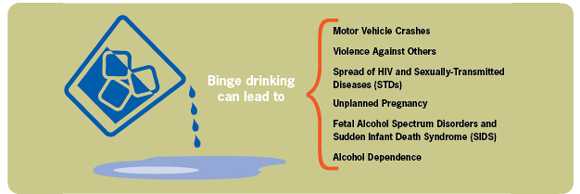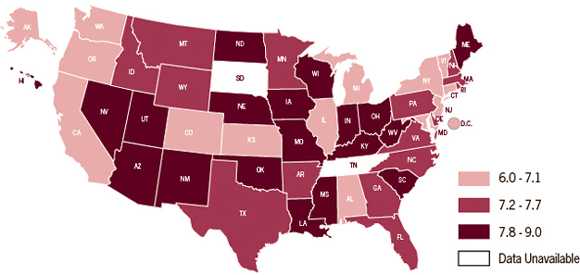Binge Drinking
Nationwide Problems, Local Solutions
January 2012


 1 in 6
1 in 6
More than 38 million US adults binge drink.
 4X
4X
Binge drinkers do so about 4 times a month.
 8
8
The largest number of drinks per binge is on average 8.
New estimates show that binge drinking* is a bigger problem than previously thought. More than 38 million US adults binge drink, about 4 times a month, and the largest number of drinks per binge is on average 8. This behavior greatly increases the chances of getting hurt or hurting others due to car crashes, violence, and suicide. Drinking too much, including binge drinking, causes 80,000 deaths in the US each year and, in 2006 cost the economy $223.5 billion. Binge drinking is a problem in all states, even in states with fewer binge drinkers, because they are binging more often and in larger amounts.
*Binge drinking means men drinking 5 or more alcoholic drinks within a short period of time or women drinking 4 or more drinks within a short period of time.
Problem
Binge drinking is a dangerous and costly public health problem
Binge drinking is a bigger problem than we thought.
- Binge drinking is about more than just the number of binge drinkers. The amount and number of times binge drinkers drink are also important to address.
- Age group with most binge drinkers: 18-34 years
- Age group that binge drinks most often: 65+ years
- Income group with most binge drinkers: more than $75,000
- Income group that binge drinks the most often and drinks most per binge: less than $25,000
- Most alcohol-impaired drivers binge drink.
- Most people who binge drink are not alcohol dependent or alcoholics.
- More than half of the alcohol adults drink is while binge drinking.
- More than 90% of the alcohol youth drink is while binge drinking.
Binge drinking costs everyone.
- Drinking too much, including binge drinking, cost $746 per person, or $1.90 a drink, in the US in 2006. These costs include health care expenses, crime, and lost productivity.
- Binge drinking cost federal, state, and local governments about 62 cents per drink in 2006, while federal and state income from taxes on alcohol totaled only about 12 cents per drink.
- Drinking too much contributes to over 54 different injuries and diseases, including car crashes, violence, and sexually-transmitted diseases.
- The chance of getting sick and dying from alcohol problems increases significantly for those who binge drink more often and drink more when they do.

How many people binge drink? How often? How much?

SOURCE: 2010 Behavioral Risk Factor Surveillance System Combined Landline and Cell Phone Developmental Dataset, adults aged 18 and older, US
U.S. State Info
Percent of adults who binge drink
Binge drinking varies from state to state, and estimates of adults who binge drink range from 10.9% in Utah to 25.6% in Wisconsin. Binge drinking is most common in the Midwest, New England, the District of Columbia, Alaska, and Hawaii.

SOURCE: 2010 Behavioral Risk Factor Surveillance System Combined Landline and Cell Phone Developmental Dataset, Adults Aged 18 and Older, US
The average largest number of drinks within a short period of time among binge drinkers ranged from 6 drinks in the District of Columbia to 9 drinks in Wisconsin. The largest number of drinks consumed by binge drinkers is highest in the Midwest and southern Mountain states (Arizona, Nevada, New Mexico, and Utah), and some states such as Louisiana, Mississippi, and South Carolina where binge drinking is less common.
The average largest number of drinks consumed by binge drinkers on an occasion

SOURCE: 2010 Behavioral Risk Factor Surveillance System Combined Landline and Cell Phone Developmental Dataset, Adults Aged 18 and Older, US
What Can Be Done
Everyone can help prevent binge drinking.
The US Government can
- Collaborate with states and communities to support effective community strategies to prevent binge drinking strategies such as those recommended by the Community Guide.*
- Assist states and communities in tracking how many people binge drink, how often, and how much they drink when they binge.
- Help states and communities track and understand the laws and regulations that control the marketing and sale of alcohol.
- Collaborate with states and communities to determine whether prevention strategies are working.
States and communities can
- Implement effective community strategies to prevent binge drinking such as those recommended by the Community Guide.*
- Routinely track and report how many people binge drink, how often, and how much they drink when they binge.
- Develop community coalitions that build partnerships among schools, community- and faith-based organizations, law enforcement, health care, and public health agencies to reduce binge drinking.
Doctors, nurses, and other providers can
- Recognize that drinking too much causes 80,000 deaths in the US each year and contributes to over 54 different injuries and diseases.
- Recognize that most binge drinkers are not alcohol dependent or alcoholics.
- Support effective community strategies to prevent binge drinking such as those recommended by the Community Guide.*
- Screen patients for binge drinking and advise those who do to reduce their use. More information can be found at http://www.uspreventiveservicestaskforce.org/uspstf/uspsdrin.htm.
People can
- Choose not to binge drink themselves and help others not to do it.
- Drink in moderation if they do drink. The US Dietary Guidelines on alcohol consumption recommend no more than 1 drink per day for women and no more than 2 drinks per day for men. Pregnant women and underage youth should not drink alcohol.
- Support effective community strategies to prevent binge drinking, such as those recommended by the Community Guide.*
- Support local control of the marketing and sale of alcohol.
- Support the minimum legal drinking age of 21.
*The Community Guide recommendations can be found at http://www.thecommunityguide.org/alcohol.
Science Behind the Issue
Related Pages
- Vital Signs Issue details: Morbidity and Mortality Weekly Report (MMWR)
- CDC Alcohol and Public Health Website
- Binge Drinking Vital Signs PODCAST – 01:15 minutes]
- Binge Drinking [VIDEO – 04:23 minutes]
- Binge Drinking Vital Signs Web Feature
- Motor Vehicle Safety: Impaired_Driving
- Fetal Alcohol Spectrum Disorders website
On Other Web Sites
- The Community Guide: Preventing Excessive Alcohol Consumption
- MedlinePlus – Alcoholism and Alcohol Abuse
- Page last reviewed: January 10, 2012
- Page last updated: October 10, 2013
- Content source:
- National Center for Chronic Disease Prevention and Health Promotion, Division of Population Health, Alcohol and Public Health, Division of Reproductive Health, National Center on Birth Defects and Developmental Disabilities, Fetal Alcohol Spectrum Disorders, Office of Women’s Health
- Page maintained by: Office of the Associate Director for Communications (OADC)


 ShareCompartir
ShareCompartir